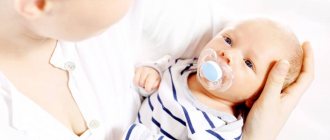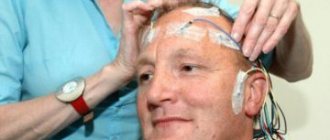General information
Affective-respiratory attacks are attacks of spasmodic crying or severe anxiety of a child with “sunset” in conditions of a negative emotional reaction. They are most often observed in children from six months to one and a half years and manifest themselves in the form of episodic short-term breath holding ( apnea ), which can be accompanied by apneic convulsions and loss of consciousness .
Despite the frightening manifestations, seizures are not life-threatening for the child, and subsequently, upon reaching the age of three to five, they disappear spontaneously, and therefore do not require treatment. No more than 5% of the population suffers from affective-respiratory attacks, regardless of the gender of the child. A positive family history was identified in 25% of cases.
What you need to know about ARP
The children's nervous system reacts sharply to any stressful situations, so ARP in children is not uncommon and not a reason to panic. The disorder occurs at least once in a lifetime in every fourth child under the age of four.
If the disorder is not associated with organic pathologies, brain diseases or a lack of important microelements, parents do not need to worry. You can get rid of the disorder on your own, without the use of drug therapy, but this will require patience.
Having understood the mechanism of development of attacks, under no circumstances should you scold the child or ask him to stop. Stopping breathing occurs reflexively, in response to crying, and the baby himself cannot do anything about it.
Despite the frightening symptoms, the attacks are not harmful to health. With age, a person’s nervous system strengthens and affective attacks disappear without a trace.
Pathogenesis
Affective-respiratory manifestations occur in conditions of increased nervous reflex excitability and a tendency to hysteroid reactions. When a child cries or screams, a spasm of the larynx occurs and breath holding may occur during the inhalation stage, which causes pallor or cyanosis of both the skin and mucous membranes of the mouth. The result of developing hypoxia is a disruption of the regulation of the autonomic nervous system, the development of tonic convulsions, and short-term fainting, which last from several seconds to several minutes.
Classification
Depending on the pathogenesis and completeness of the clinical picture, effective respiratory attacks in children are of different types:
- The usual type is a classic manifestation of an affective-respiratory attack - holding your breath while inhaling, which occurs as a result of injury or frustration - the inability to satisfy certain needs, outwardly resembles laryngospasm .
- Blue type - neurotic or neurosis-like attacks are the result of anger, frustration, and sometimes pain; while crying, the child may exhale forcibly, holding his breath occurs, which causes vegetative-vascular disorders: cyanosis (blueness of the skin), loss of muscle tone, dilated pupils and syncope, most often children regain consciousness on their own or fall asleep for several hours; This type of affective-respiratory seizures is characterized by the absence of a postictal phase and a normal EEG.
- Pale or white type (affective-respiratory syncopation) - unlike the blue type, it causes pallor of the skin, asystole and occurs during crying or its absence; also, with a normal EEG, it leads to fainting and does not have a post-ictal phase.
- Affectively provoked epileptic seizures or the so-called complicated type are considered a more pronounced and severe form of the types of seizures described above, which begin as “blue” or “pale” and turn into a pseudo-epileptic seizure; the EEG outside of seizures is usually normal.
Apnea in infants
Apnea is a sudden stop in breathing that is not associated with emotional stress.
Infants and newborns are susceptible to the disease. In adults, apnea may occur during severe skin irritation. A particular danger is the sudden cessation of breathing during sleep apnea. In this case, breathing stops for more than 25 seconds, which can have negative consequences for the child. The disorder should be treated, otherwise a number of neurological pathologies may develop, including disruption of the baby’s development.
Sudden breathing problems during sleep are a cause for concern. In infants, the disorder may develop for the following reasons:
- trauma during childbirth;
- congenital anomalies of the structure of the nose;
- swelling of the mucous membrane of the nasopharynx due to colds and viral diseases;
- severe obesity.
At older ages, such disorders are rarely observed. Stopping breathing in children over 8 months of age is directly related to the emotional state of the child and, according to many experts, is the first harbinger of neurosis and hysteria in the future.
Causes
As a manifestation of a heightened emotional state, affective-respiratory seizures are the earliest manifestation of hysterical paroxysms and usually occur in response to:
- feelings of disappointment, anger, fear, joy and other strong emotional shocks;
- force feeding;
- severe pain, for example, when falling from a height, “pale syncopation” occurs as a result of reflex asystole, which is especially dangerous for children with heart disease.
neurasthenia and neurosis , overprotection, vitamin D metabolism disorders, hypocalcemia and hypohemoglobinemia can contribute to the development of attacks of abnormal breathing .
Video on the topic
Dr. Komarovsky about affective-respiratory attacks in children:
Thus, affective-respiratory paroxysms do not pose a great danger to the life of the baby. But they need to be treated to prevent serious consequences from occurring. It is important to identify and eliminate the cause of the development of breath-holding attacks. It is important to approach solving the problem comprehensively. You cannot self-medicate. It is required to strictly adhere to the treatment regimen proposed by the doctor and carry out preventive measures.
Symptoms
Depending on the type of affective-respiratory seizure, the symptoms may differ, but in general they consist of the following reactions:
- respiratory arrest caused by screaming or crying;
- turning blue or pale;
- severe hypotension (the child goes limp);
- short-term loss of consciousness, which may be followed by several hours of sleep;
- involuntary urination;
- the occurrence of seizures.
If affective-respiratory paroxysms are not stopped in time, then subsequently the child may experience hypoxia:
- short-term loss of consciousness;
- clonic-tonic or tonic convulsions ;
- post-attack lethargy and drowsiness;
- enuresis.
Prevention
To prevent affective-respiratory paroxysms in a child, experts give parents the following recommendations:
- do not shout or punish the baby. It is better to try to calmly explain to the baby what he is wrong about;
- treat the child like an adult. It is important to take into account the baby’s opinion, his interests, preferences;
- provide rational, balanced nutrition. It is necessary to ensure that the child is not hungry;
- If the baby is capricious and crying, then you need to switch his attention from the problem that worries him and calm him down. This will prevent an emotional reaction from developing.
Komarovsky about affective-respiratory attacks in children
The best person to explain what an affective-respiratory attack is is Dr. Komarovsky, popular and beloved by all mothers. In his television program “Ask Dr. Komarovsky,” he says that a seizure usually begins with a situation where a child is under the influence of some unpleasant external factors, for example, fear or refusal to do what he wanted, as well as pain and fright.
The child begins to cry hysterically, and his breathing stops for some time - so to speak, the child “breaks down crying.” In medical science, this condition is called an affective-respiratory attack, that is, in a state of uncontrollable negative strong emotion - in a state of passion , a sudden stop in breathing occurs.
As a rule, these paroxysms can begin after 6 months of life and, without any treatment, end sooner or later. Usually at a maximum of 4, extremely rarely - at 4.5-5 years, affective-respiratory attacks outgrow and they are a certain stage in the development of the nervous system. They, most often, do not need any treatment, although it is recommended to show the child to a doctor, because a situation can still be dangerous to health when:
- stopping breathing lasts more than a minute, this happens extremely rarely;
- in a child, severe reflex anoxic seizures with breathing stops for more than 30 seconds occur more often than 2-3 times a week.
What to do in case of affective-respiratory attacks?
The main task is to prevent the child from falling, and therefore from being injured, so it is best to calmly approach the baby, hug him, thereby preventing a fall. It is important not to make the parent himself hysterical and not to change his face. In addition, you can put something cold on the child's face or even wet your hand with cold water and splash it on the child. The main thing is to treat this calmly; the child always outgrows it if the syndrome is not a reason for personal hysterics and panic among parents and relatives.
If the seizure was provoked by the failure to fulfill the child’s wishes, then you need to understand that after the child has come to his senses, you cannot succumb to provocation - do not do what the baby wanted, do not discuss what happened and do not punish. It’s good if the mother or father pretends that nothing happened. Otherwise, you are suggesting the wrong mechanism for solving problems and contributing to the development of neurasthenia in the future.
What to do during an attack?
First of all, don’t panic yourself. The emotional state of the surrounding adults is transmitted to the baby, and if confusion and fear are “stirred up,” it will only get worse. Hold your breath yourself. Feel that nothing bad happened to you and your baby due to the temporary delay in breathing movements. Blow on the baby's nose, pat his cheeks, tickle him. Any such impact will help him quickly recover and breathe.
During a prolonged attack, especially with convulsions, place the baby on a flat bed and turn his head to the side. This will prevent him from choking on vomit if he vomits. Spray him with cold water, wipe his face, and gently tickle him.
If during an attack parents “tear out their hair,” then the baby’s condition becomes more serious. After an attack, even if there were convulsions, give the baby a rest. Don't wake him if he's asleep. It is important to remain calm after an attack, speak quietly, and not make noise. In a nervous environment, the attack may recur.
For any attack with convulsions, you should consult a neurologist. Only a doctor can distinguish ARP from epilepsy or other neurological disorders.
Make an appointment with your doctor if this happens for the first time. It is necessary to distinguish between illness and affective reaction. If the attack has happened more than once, but there is no illness, you need to think about raising the baby.
If this happens to your baby for the first time, you should call a pediatric ambulance, especially if convulsions occur. The pediatrician will assess the severity of the condition and decide whether hospitalization is required. After all, parents are not always able to fully monitor their baby, and this is how the consequences of a traumatic brain injury, poisoning or acute illness can manifest themselves.
Simple rules for parents
The task of parents is to teach the child to manage his anger and rage so that it does not interfere with the lives of the rest of the family members.
Discontent, anger and rage are natural human emotions; no one is immune from them. However, boundaries must be created for the baby, which he has no right to cross. To do this you need this:
- Parents and all adults living with the child must be united in their requirements. There is nothing more harmful for a child when one allows and the other forbids. The child grows up to be a desperate manipulator, from whom everyone then suffers.
- Place in a children's team. There, the hierarchy is built naturally, the child learns to “know his place in the pack.” If attacks occur on the way to the garden, you need to consult a child psychologist, who will specifically indicate what needs to be done.
- Avoid situations where an attack is likely to occur. The morning rush, a queue at the supermarket, a long walk on an empty stomach - all these are provoking moments. It is necessary to plan the day so that the baby is well-fed, has sufficient rest and free time.
- Switch attention. If a child bursts into tears and the crying intensifies, you need to try to distract him with something - a passing car, a flower, a butterfly, snowfall - whatever. It is necessary not to let the emotional reaction “flare up” .
- Clearly define boundaries. If a child knows for sure that he will not receive a toy (candy, gadget) from either his grandmother or aunt, if his father or mother forbade it, then after the most desperate crying he will still calm down. Everything that happens needs to be spoken in a calm tone. Explain why crying is useless. “Look, no one in the store is crying or screaming. It’s impossible - it means it’s impossible.” Sensitive children need to add that mom or dad loves him very much, he is good, but there are rules that no one is allowed to break.
- Call a spade a spade and pronounce the consequences of whims. “You're angry and I can see it. But if you continue to cry, you will have to calm down alone in your room.” You need to be honest with children.











